It’s easy to take healthy hooves for granted. For most of us, hoof care means calling the farrier out every six weeks or so, along with an occasional once over and clean outs with the hoof pick every few days. But many of the choices you make every day—from the feeds you offer to the footing you ride on—can have a significant influence on the health of your horse’s hooves. Here are four easy ways to manage your horse for healthy and strong hooves.
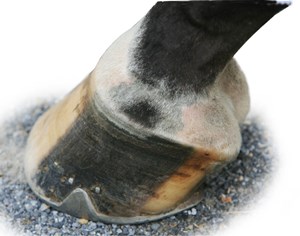 Credit: Janis Tremper
Credit: Janis TremperBALANCE HIS DIET
Good nutrition supports the health of the entire body, including the hooves. To grow hard, healthy hoof horn, a horse needs a diet with the proper balance of nutrients and minerals.
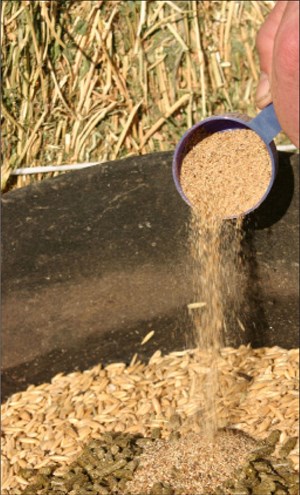 Credit: Janis Tremper
Credit: Janis TremperThe average pleasure horse can usually get all the nutrients he needs from a good quality pasture or hay, supplemented with a commercially prepared concentrate formulated for his stage in life, if necessary. If you have any doubts about the quality of your horse’s diet, “have a qualified equine nutritionist evaluate your hay and grain, and feed according to their recommendations,” says Red Renchin, a farrier in Mequon,Wisconsin, who specializes in show hunters and jumpers.
Of course, you don’t want to give your horse too much of a good thing, either. “Beyond the obvious risk of laminitis from overfeeding, a very heavy horse can literally ‘crush’ his hooves under his weight,” says Mike Miller, a Huntsville, Alabama, farrier and author of The Mirage of the Natural Foot: Science and Snake Oil in the Barefoot Trimming Debate. “And the bigger load will affect his joints as well. We like to give sweet feed to our horses because they enjoy it, but remember they are built to live on grass and forage, and most can do so easily.”
Beyond the basics of good nutrition, feeding a supplement containing biotin can also help support your horse’s hoof health. A B vitamin, biotin supports the production of keratin, a protein that provides the structural basis for hair and hoof horn. Studies have shown that supplements containing biotin improve the growth rate and quality of hooves. “If a horse owner wants to feed a supplement, I’d tell them to look for one with biotin on the label,” says Miller.
KEEP HIM MOVING
If a horse has fragile feet, you might think that restricting his exercise will reduce the risk of cracks and other troubles. But in fact the opposite is true: Regular exercise promotes hoof health.
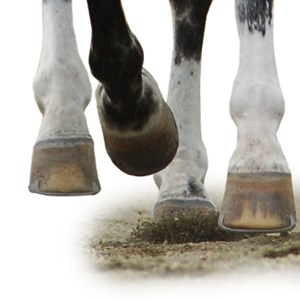 Credit: Mane Photo
Credit: Mane Photo“The simple act of walking stimulates blood flow within the hooves, which brings in nutrients,” says Miller. The work of continual loading and unloading with each step also increases metabolic activity in the foot, which causes it to produce better quality hoof at a faster rate than if the horse were just standing still most of the day. “You may have noticed your own fingernails grow faster if you’re doing manual work. The horse’s hoof reacts in a similar way to the pressure of movement.”
This doesn’t mean that a horse with poor hooves needs to be forced into an extreme exercise regimen. A horse turned out in a large pasture around the clock will walk enough on his own to benefit his hooves. If 24-hour turnout is not an option, let him stay out as often and as long as possible and ride him regularly.
If your otherwise sound horse has a hoof crack or defect that makes you nervous about riding him, examine it closely. If the crack does not spread with each step the horse takes, it’s stable enough to ride on.
FOCUS ON FOOTING
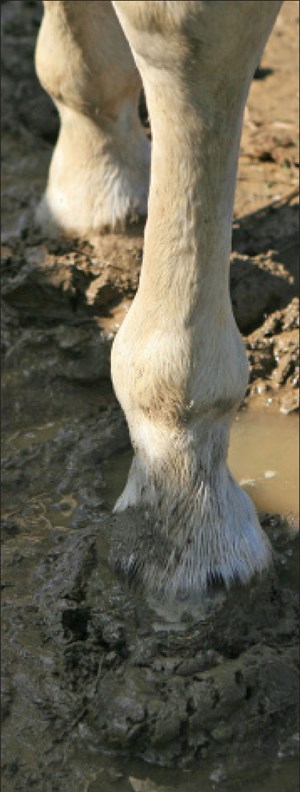 Credit: Mane Photo If your pastures are chronically muddy during the rainy season, consider spreading sand or gravel around feeders, gates and over other high-traffic areas.
Credit: Mane Photo If your pastures are chronically muddy during the rainy season, consider spreading sand or gravel around feeders, gates and over other high-traffic areas.The ground conditions in a horse’s habitat can affect his hooves for better or worse. “Conditions that are extremely dry will cause a foot to shrink and harden. Conversely, a wet, swampy environment will cause a foot to weaken and spread,” says Renchin. “Ideally, you want something not too hard and not too soft, not too wet and not too dry.”
Sudden changes in footing can also be damaging. “If you take a horse kept in very wet surroundings without shoes and ride him in a stone arena or on hard soil, his hooves will just melt away,” says Miller. “They are just too soft to stand up to that sort of footing.”
Striking the right balance between wet and dry, hard and soft may require some changes to your stalls, pastures and arena. The ideal stall bedding, for example, “molds” to the bottom of the foot, to support the sole and frog as well as the hoof wall.
“In my part of the country, every hoof is packed with Alabama clay, and that’s a good thing,” says Miller. “Without that packing, the hoof wall is holding the majority of the horse’s weight, which is stressful. Ideally, the foot forms a composite weight-bearing structure with the soil to share the load. If you’re stabling on mats, put in a layerof gravel or a lot of bedding to give the horse something resilient to stand on and pack in the foot. A great combination for stable flooring would be gravel, dirt and shavings to keep it all dry.”
Obviously, surface conditions are more variable and difficult to control in pastures. But you can take some measures to improve your horse’s footing. If you get chronically wet, muddy ground during each rainy season, for example, consider spreading sand or gravel in some areas—especially high traffic“hangouts” such as around the feeders—to give them some respite from standing in the muck. The goal, says Renchin, is always “to provide safe, level, firm, rock-free turnout.”
In the riding arena, select footing that “cups” below the horse’s hoof with each step, advises Miller. “A lot of dressage riders will use a sand base in the arena. And if you look at a footprint, you’ll see a complete mold of the bottom of the hoof. That means it’s supporting it with each stride, which is good.” Other surfaces can provide similar support.
With all that said, however, “Riding over a variety of terrains can be very helpful to a horse’s hooves,” says Miller. “They will acclimate to all types of footing. Look at the eventers; they ride over all sorts of stuff in the course of a single day.”
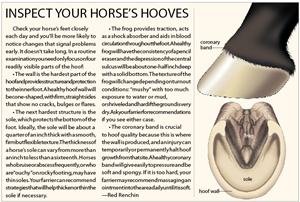
KEEP AN EYE ON HIS FEET
As simple as it sounds, one of the best things you can do for your horse’s hooves is simply to inspect them thoroughly and regularly, preferably everyday. You’ll become much more apt to notice changes or problems early, when they are easier to address.
“Every horse deserves to have his feet picked out and looked at once a day, but that’s something I find a surprising number of horse owners don’t do,” says Miller. “Under that nice-looking mud and dirt, he may have a big rock lodged next to his frog. He may even have a penetrating wound.”
After you’ve picked out the hooves, take a few moments to examine them (see sidebar at left). Are there any new cracks or chips? Is the frog firm but supple? Take some time to learn what healthy hooves are supposed to look and feel like so you’ll be able to spot deviations. If something looks different, but you’re not sure what, take a picture for comparison a few days later. And never hesitate to call your veterinarian or farrier if anything looks unusual or off.
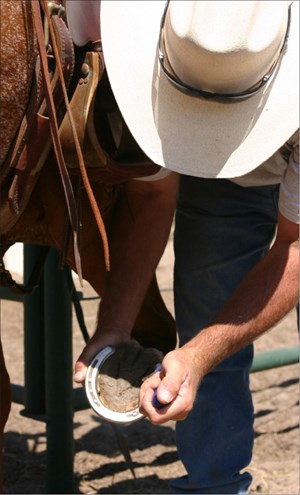 Credit: Janis Tremper One of the best things you can do for your horse’s hooves is simply to inspect them thoroughly and regularly, preferably every day.
Credit: Janis Tremper One of the best things you can do for your horse’s hooves is simply to inspect them thoroughly and regularly, preferably every day.One condition you definitely want to catch early is thrush. An anaerobic bacterial infection that penetrates the soft tissues of the foot, particularly around the frog, thrush is notoriously difficult to treat. But it’s not hard to detect—thrush is known for its black discharge and strong smell: “Thrush has peculiar, nasty odor typical of anaerobic bacteria,” says Miller. “Once you smell it, you’ll never mistake it for anything else, and it’s persistent. If you get it on your hands, no matter how much you wash them, there’s always a faint odor.”
Thrush requires moisture to grow, and it has long been associated with poor hygiene. But many factors contribute to its development, and some horses who are perfectly well cared for may develop thrush when the pasture is wet for more than a few days.
Contact a veterinarian or experienced farrier if you suspect your horse may have thrush. “Many of the home remedies are toxic to hoof tissues,” Miller says. “You’ll be killing bacteria, but also hoof tissue. Those pockets of dead tissue are perfect places for the bacteria to reestablish themselves a few days later, so you’re working against yourself. Thrush really has to be treated by a farrier, who can cut away the dead tissue and treat the condition with medicine.”
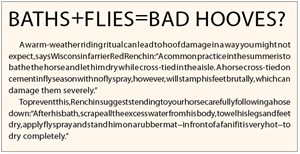
Instead of taking healthy hooves for granted, set aside a small part of your daily routine for your horse’s hooves. The reward will be strong and sound hooves for years to come.





